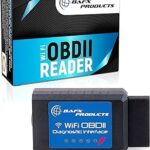Encountering a check engine light in your vehicle can be unsettling, especially when accompanied by other warning lights. Among the various trouble codes you might retrieve using an OBD2 scanner, P0700 is a common one, signaling a problem within your vehicle’s transmission control system. While this code is generic and applicable across many makes, including Dodge, understanding its implications and how tools like Autel OBD2 scanners can assist in diagnosis is crucial.
The P0700 code, as a starting point, simply indicates that your car’s Powertrain Control Module (PCM) or Engine Control Module (ECM) has detected an issue within the transmission control system. Essentially, it’s a request from your transmission control module (TCM) to turn on the check engine light. This code alone doesn’t pinpoint the exact problem but serves as an alert that further investigation is needed. You might experience symptoms accompanying the P0700 code, such as erratic shifting, the vehicle getting stuck in gear, or, as some drivers describe, a “lurching” sensation, particularly at low speeds. Alongside the check engine light, other warning indicators might illuminate, such as the BRAKE, Cruise, Traction/VDC, and AT OIL TEMP lights, creating a cascade of dashboard alerts.
To delve deeper into the issue indicated by P0700, an Autel OBD2 scanner becomes an invaluable tool. These scanners allow you to read not just the generic P0700 code but also retrieve more specific transmission-related codes that the TCM has stored. For instance, codes like P2762, which relates to a Torque Converter Clutch Pressure Control Solenoid Control Circuit, often accompany P0700, providing a more focused direction for diagnosis. Using an Autel scanner, you can access live data streams from the transmission system, monitor sensor readings, and even perform basic diagnostic tests. This level of insight goes far beyond what a generic code reader can offer and is essential for accurately diagnosing transmission problems in vehicles ranging from Subaru to, yes, even Dodge.
The diagnostic process typically involves:
- Retrieving all codes: Connect your Autel OBD2 scanner and record all present trouble codes, not just P0700. Pay close attention to codes specifically related to the transmission.
- Analyzing symptoms: Note any drivability issues, unusual noises, or warning lights that accompany the P0700 code. When did these symptoms appear? Under what driving conditions?
- Checking transmission fluid: Inspect the fluid level and condition. Low or burnt fluid can be a significant indicator of transmission problems.
- Using live data: Utilize your Autel scanner to monitor real-time data from transmission sensors. Look for anomalies in temperature readings, solenoid operations, and pressure values.
- Component testing: Based on the specific codes and symptoms, you may need to test individual components like solenoids or sensors. Autel scanners often have functionalities to aid in component testing.
While some issues indicated by P0700 might be relatively minor, such as a faulty sensor or solenoid, others can be more serious, potentially involving internal transmission damage or control module malfunctions. Attempting DIY repairs, like replacing a solenoid, can be feasible for mechanically inclined individuals, especially with guidance from online resources and diagnostic tools. However, complex transmission problems often necessitate professional diagnosis and repair.
In conclusion, the P0700 code is a crucial starting point for diagnosing transmission issues. Utilizing an advanced tool like an Autel OBD2 scanner empowers you to go beyond the generic code and access detailed information necessary for effective troubleshooting, whether you are working on a Subaru, a Dodge, or any other vehicle experiencing transmission-related problems. Remember, accurate diagnosis is the key to effective and economical repair, ensuring your vehicle remains reliable on the road.
